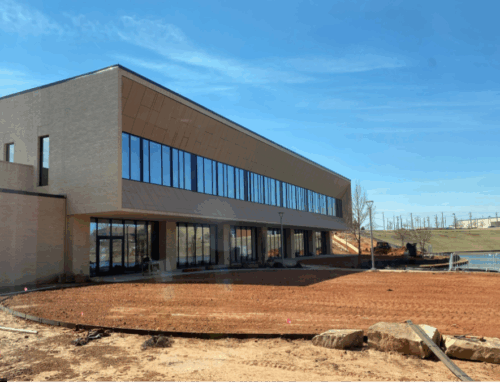If there is one issue that has kept many of us up at night recently, it is construction pricing and supply chain challenges. As Bremner Real Estate VP, Development Kevin Knue says, “It’s certainly a topic that’s heavily impacting the industry across the board. We’re living it every day.” The team is also working proactively to ensure that impacts to clients – and, of course, their end users – are minimized and projects proceed as seamlessly as possible, even when confronted with… reality.
Agility Is Key
To address the elephant in the room: COVID not only resulted in a global health crisis but precipitated virtually unprecedented pricing and supply chain snarls. As these challenges were emerging, it became increasingly necessary to pivot at a moment’s notice. For example, the Bremner team was building to a design that specified a certain structural steel system for the roof. Due to procurement timelines (read: long delays), they had to adjust the system so they could have it on site and in place when required.
AJ Misch, Bremner Development Manager, says, “You adjust to market conditions as they actualize. You start down a path with one product, for example, and find out it’s going to be here way later than needed in order to construct the building.” In the early days of pandemic chaos, he says, “We thought of different ideas, changed the design from this material to that material. We adjusted.”
Kevin adds, “It was unique because early in COVID, these were emerging changes in market conditions. What would have been a four or five month lead time turned to eight or more – and that happened very quickly. We started designing out a path; the market knowledge wasn’t out there. When the market shifted, we had to react.”
But as important as agility proves to be, so is learning on an exceedingly steep curve. “Fast forward once we know these market conditions are out there. With subsequent projects, for example, we didn’t use that [roof] system. We skipped it and went directly to a system we knew we could procure in time.”
Moving Forward
Data plays an integral role in everything from preliminary design and scheduling to procurement and construction. For example, on new projects, the team develops a preliminary schedule. Kevin explains, “We understand when we need to buy components of the development, using all of the data we have, as well as guidance from our CM partners. We then apply escalation factors so, when it comes time to buy the project out, we have those contingencies set aside. The goal is that there are no surprises on the budget once it comes time to purchase.”
A component both as fundamental and as critical as a generator requires careful thought, especially as a typical lead time of four months has grown to a year. AJ says, “The design team may not have had that in their normal schedule until further on in the development. But as our teams are aware of the conditions in the market, we know we need to buy early. Our design partners work with us to analyze the design of the generator much earlier in the project so we can move forward with procurement.”
Of course, supply shortages and delays are not the only juggernauts that the industry is facing. Pricing is certainly rearing its ugly head. Steel and lumber each saw peaks of 200%+ increases coinciding with and following COVID. Kevin, AJ, and the team work to identify items that are long lead items and/or rapidly escalating components of a project.
Kevin explains, “We strive to get early design packages on those components and buy as soon as possible.” Not only does this build in a bit of a cushion in the schedule to allow for long lead items, “It allows us to lock in pricing based on market conditions at an earlier point than if we waited.” Goal: No surprises.
Constant Communication
Data without context tells an incomplete story. Bremner gets the full picture by working with their CM partners. AJ explains, “When you’re in the early design phase, say that there’s a high escalation currently on structural steel. We assess with the team whether it makes sense to change materials, if there’s a benefit financially and in terms of scheduling. We weigh the options as far as speed to market and budget. Having those conversations with partners is essential.”
Engaging in these conversations as soon as possible is a must when it comes to construction pricing and potential impacts. Kevin adds, “We are encouraging these conversations on material procurement and selection very early in the design process. What that allows us to do is deliver early design packages… which allows us to do early buying… which allows us to have more procurement time so materials hit the job site at the right time.”
Forward-thinking about potential challenges based on market conditions, as well as catering design and procurement strategies to align with those conditions is vital in delivering on client expectations.
Health systems are acutely aware of construction pricing and its impacts through the scope of their normal maintenance operations. When dealing with larger-scale projects, ensuring clients are updated and informed, especially when it comes to supply chain issues and mitigation initiatives, is critical. “We need to ensure they are up-to-speed with the steps we’re taking so they can be on board with that process, whether it’s early procurement or storage of materials. They’re in the loop.”
In the loop is exactly where health systems need to be when it comes to projects that will further their missions and allow them to provide the highest quality care to their end-users.
Construction Pricing and Supply Chain Challenges
People often ask when construction pricing and supply chain challenges will ease… when they will level out… When will we get back to “normal”? Understandable – but perhaps these are the wrong questions. Rather: What can we do to anticipate these challenges? To adjust and adapt to current conditions? To mitigate impacts? To deliver the quality health systems need and end-users deserve?
Now, these are the questions we need to ask – and the solutions enable efficient, effective delivery of complex, far-reaching projects.






